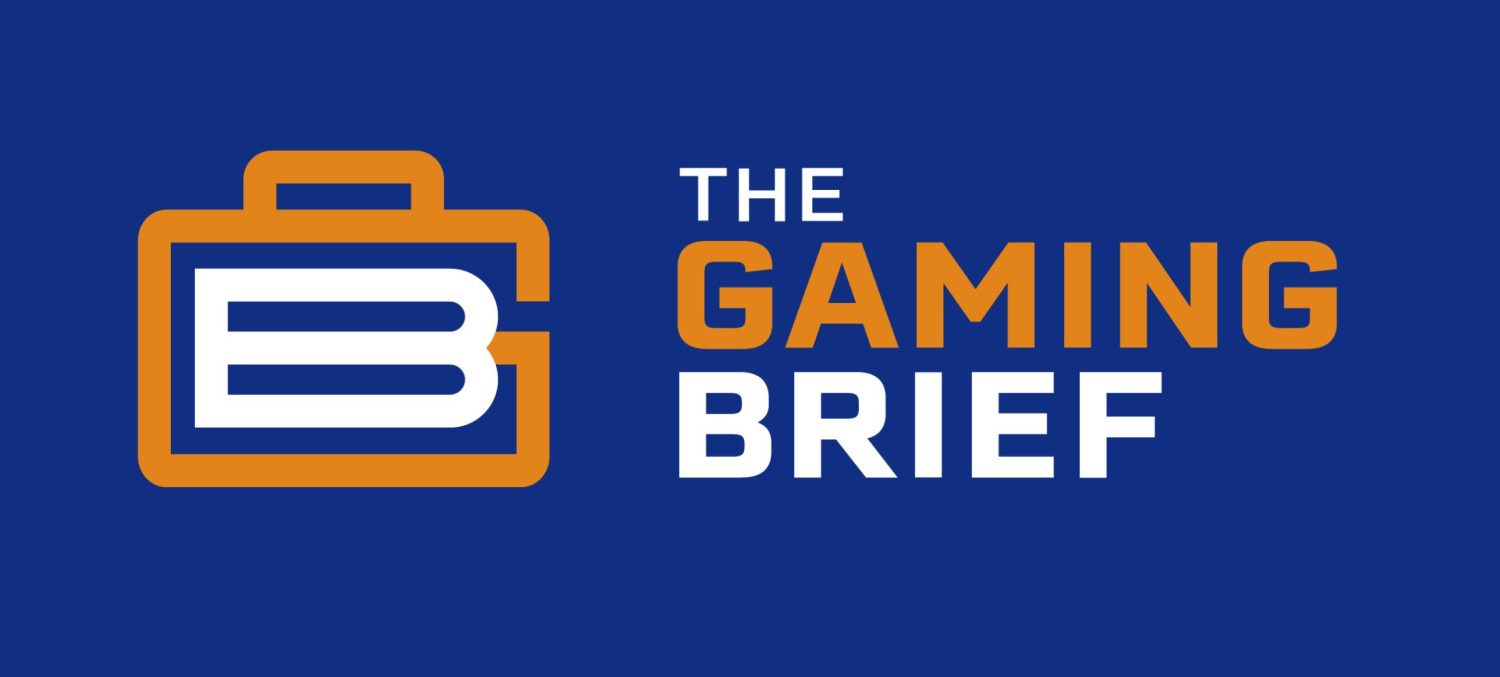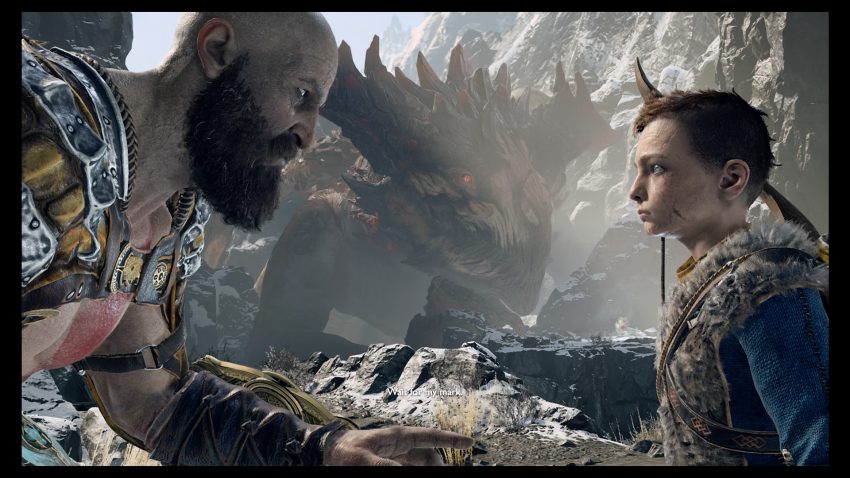In God of War, almost everything about the past games in the series has been thrown out. Apart from using Kratos’ back-story as grounding, the narrative, visual style, combat, controls and structure have all been rebuilt from the ground up to deliver an unforgettable experience.
It’s easily one of the best games of the generation and a masterpiece in modern storytelling.
The God of War Adds Atreus
Everything has changed for the Ghost of Sparta since the conclusion of God of War III. In previous iterations in the series, Kratos was a one-dimensional character. He locked on to a singular focus and murdered everyone that got in the way of his mission in a blood-soaked, screaming rage. Now Kratos now has a motivation beyond vengeance: teaching his son, Atreus, how to avoid making the same mistakes that haunt him.
By adding Atreus, God of War immediately adds humanity to the series. Instead of traversing the world of Midgard alone, you’re accompanied by your son for the entire game. When constructing a game with an AI companion that follows you for the entire game, developers always set themselves up for praise or condemnation from players. For every Elizabeth from Bioshock Infinite or Ellie from The Last of Us, there are countless great games that are hampered by an AI that trips up your experience (such as Ashley from Resident Evil 4). I am pleased to report that Atreus complements Kratos’ weaknesses and adds to the combat flow of the game. He may be the greatest AI companion ever included in a video game.
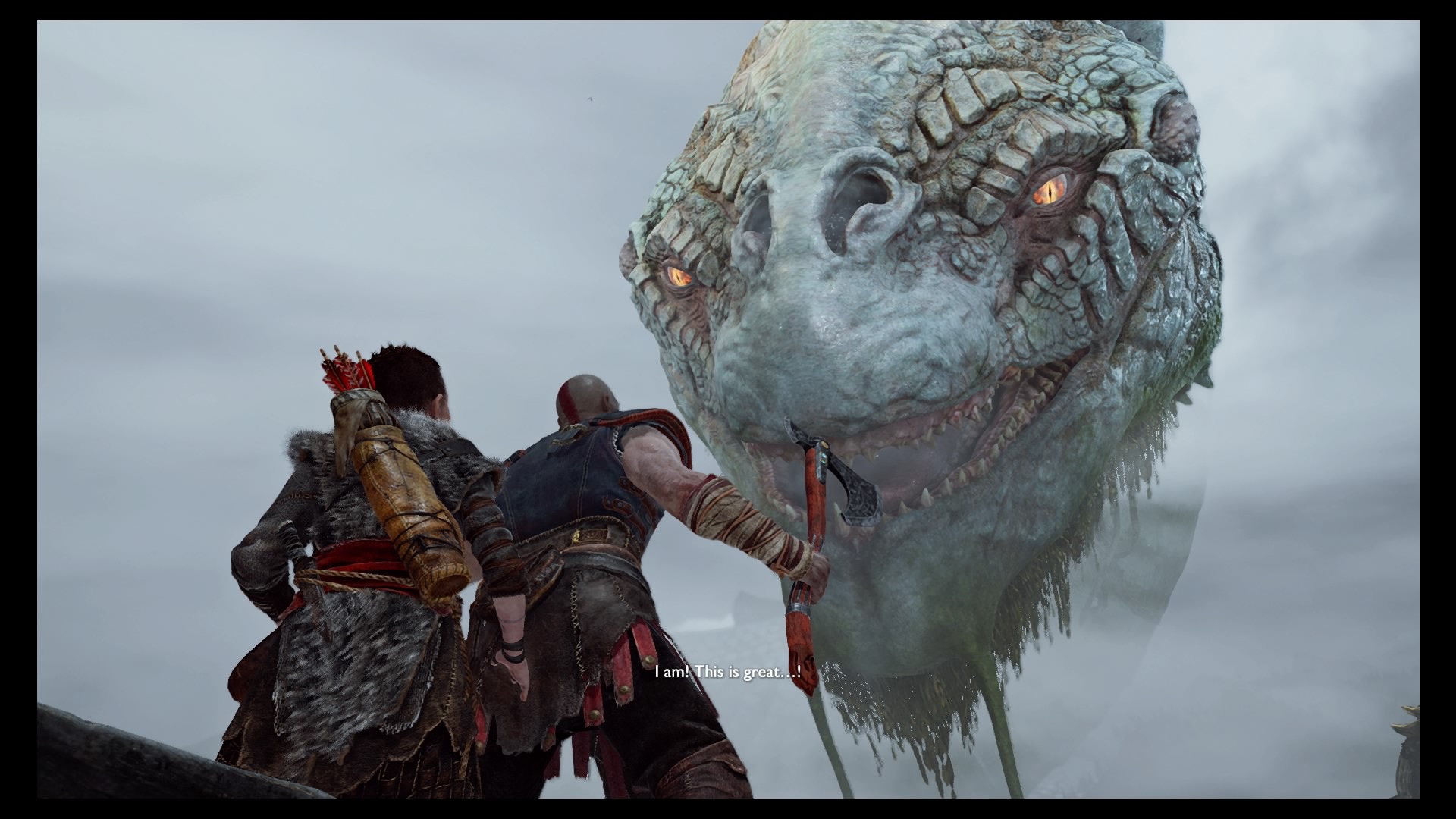
Changing the Feel of God of War
Along with the changes to the story, the game is mechanically dissimilar to all other iterations in the series. The original God of War feels like controlling a feather compared to this new game; controlling Kratos now feels very weighty. The welcomed change in feel is caused by a few big changes: a new control scheme and a change in combat style.
In addition to removing Kratos’ jump, Sony Santa Monica has moved attack actions from the face buttons to the Dualshock 4’s right triggers (R1 and R2). It may feel unorthodox to long time fans of the series, but the improved mechanics offer a satisfying shift in the combat. Instead of swinging the fiery Blades of Chaos to defeat every enemy around you, Kratos now fights principally with the icy Leviathan Axe. This weapon — along with blocks, parries and rolls utilizing the new collapsible shield — has led to more involved and deliberate combat. Atreus also contributes to the combat equation with his trusty bow and arrows. Instead of floating through encounters, Kratos brawls with a forward momentum that feels incredibly satisfying to master.
You can also throw your axe, which can also help solve puzzles. Much like Marvel’s Thor and his Mjölnir, the Leviathan Axe is special. You can swiftly recall it after being thrown or leave the weapon and recall it when you’re halfway across the world. I implore you to leave your weapon, traverse a large part of the world and not smile when the weapon takes a few extra seconds to re-appear in your hand.
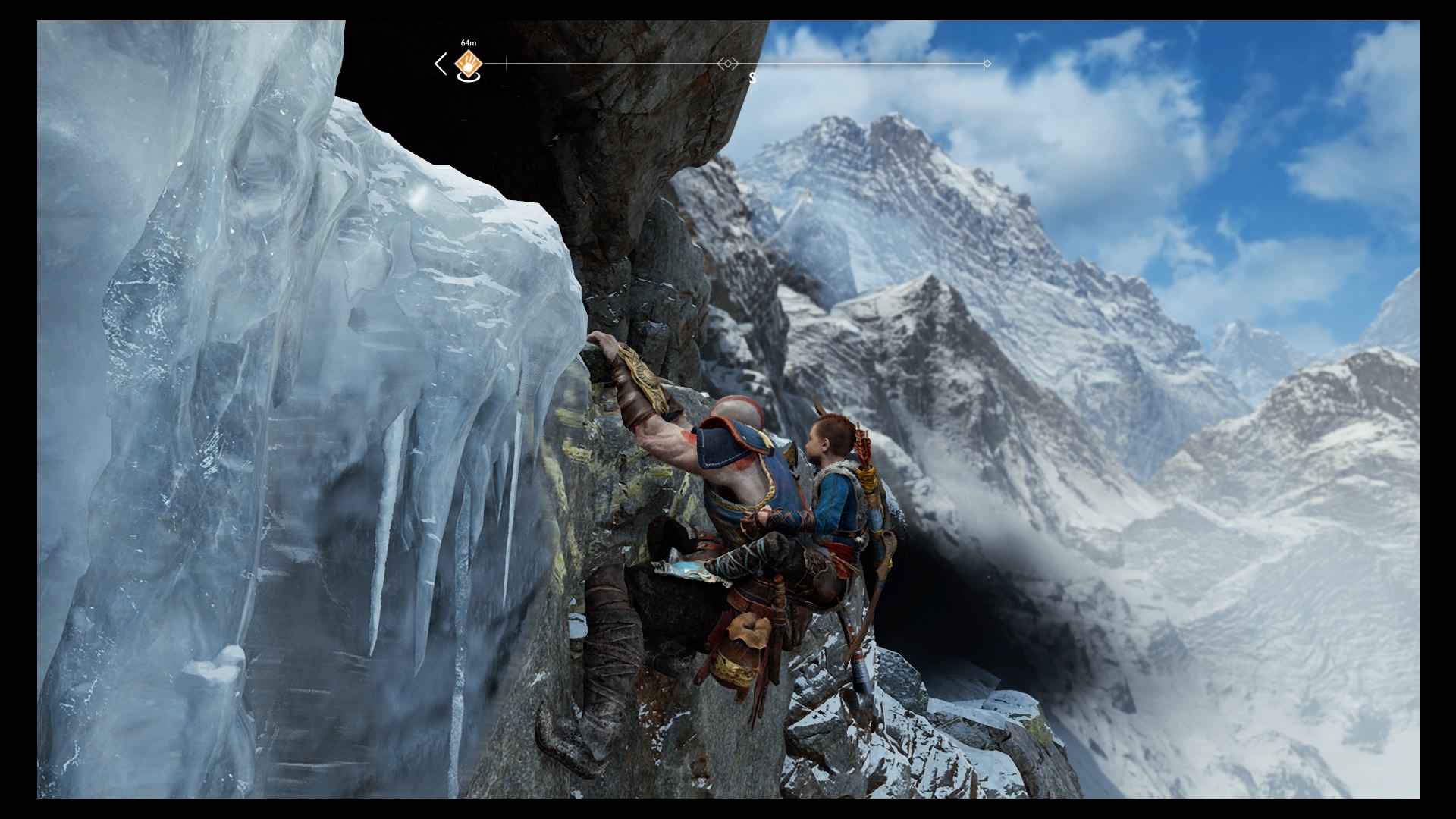
Even climbing feels uniquely heavy in this game. In an Uncharted or Tomb Raider game, your character will jump easily from point-to-point. In God of War, with your son on your back, you will need to point your camera in the direction of the next hand-hold before you jump.
Helpful Cues
During the combat, you’ll learn to appreciate the flawless UI. Bottom left, you will find your health and rage meters (build it up and you’ll be able to access the superhuman Spartan’s Rage) alongside your three special abilities. On the right-hand side, you’ll find information about Atreus’s bow and his special ability. Since the camera is tight to Kratos, enemies will sometimes be able to move behind you. But, fear not, for that’s when the smart visual cues will point in the direction of the incoming enemies. Context sensitive size and color markers will appear around Kratos and your companion will prompt you with audio cues. They shout directions and you move out-of-the-way (“…to your right” or “behind you”, for instance). Enemies even signal their critical moves with yellow and red rings before they attack.
A “No-Cut” Camera
But none of these changes would be as satisfying if the game used the perspective from the previous iterations. The camera has been moved to directly behind the back of Kratos in order to show every brutal action up-close and personally. One of the biggest achievements that the game produces is the “no-cut camera”. God of War does not fade or cut a single time before the credits roll. It’s a technical achievement that elevates the game’s narrative to new heights and has not previously been done. Movies like Birdman reproduce this effect with creative cuts, but this effect could not be fully reproduced in any other medium.
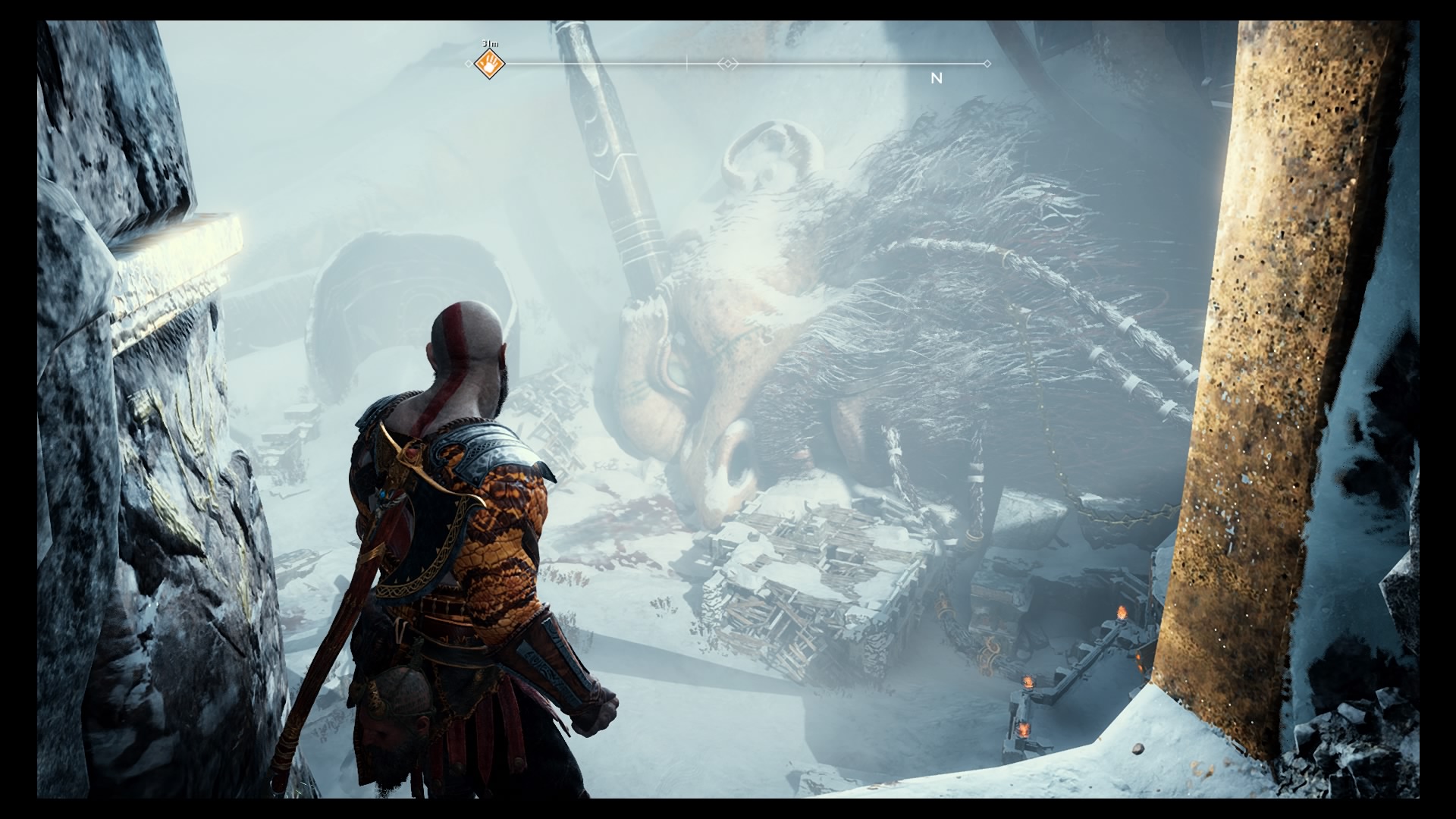
The Story in God of War
Without spoiling details of the top-notch tale grounded in the world of Norse Mythology, the story is excellent. The game’s writing, voice performances and direction are some of the high points of the experience. Christopher Judge (the voice/motion capture for Kratos) and Sunny Suljic (the voice/motion capture for Atreus) have a father-son chemistry that leaps off the screen. The game’s script takes the groundwork laid by fatherly characters’ like Tomb Raider’s Conrad Roth, The Last of Us‘ Joel and Horizon Zero Dawn’s Rost and surpasses it. Throughout the experience, Kratos teaches and guides his boy with the hope of nurturing a man who does not repeat his mistakes. Truly, it is a game whose first hour is just as powerful as its fifteenth as it moves seamlessly in and out of scripted moments, big and small.
The growth of the father-son relationship between Kratos and Atreus, however, are the moments that elevate this game above the pack. Even the smallest instances carry great weight; while rowing your boat on the Lake of the Nine with Atreus, Kratos begins to mince words with his son. When the fight got heated, the game took away control in the middle of the lake while Kratos hammered his most important lesson home. It was unexpected and surprising in a new way for the God of War franchise. We all expect to be wowed with huge set-piece moment, but to be wowed with a father-son squabble is in many ways more exciting.
Long time fans of the series will be pleased to know that God of War still has some insane set-piece moments. Remember the first battle with Poseidon in the opening minutes of God of War III? Within the first hour alone, there will be two moments that will have your mouth agape. Showing the strength of this game’s narrative, one is a father-son moment between Kratos and Atreus and the other is an epic confrontation with “The Stranger”. This fight sets the foundation of the house of cards built throughout the game’s story. As this is a spoiler-free review though, you’ll have to play yourself to witness these and many other jaw-dropping moments.
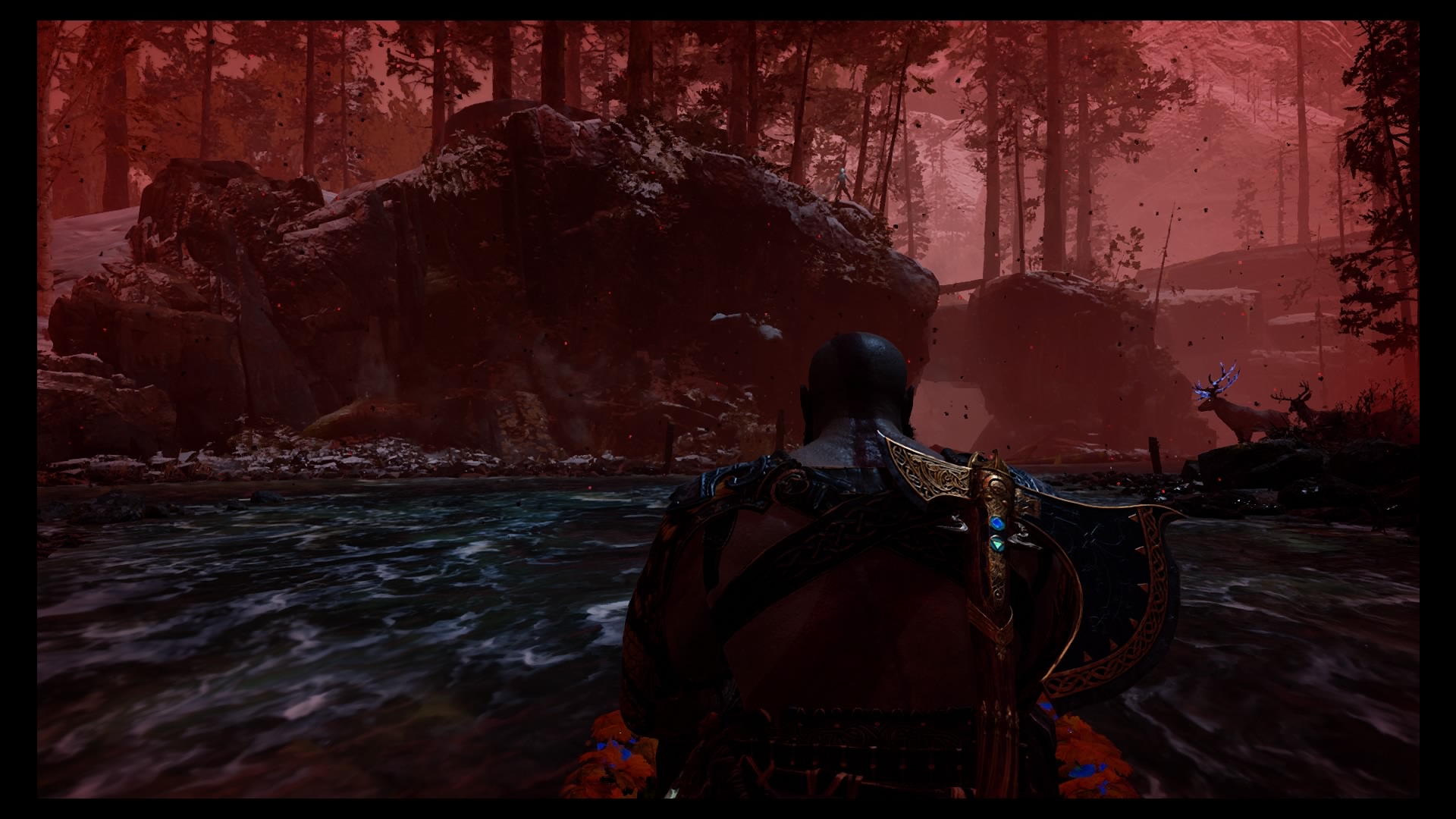
Surprisingly, the game is also genuinely funny. Kratos’ character is much more nuanced in this game, but there are still moments where he delivers his lines in that nostalgic and deliberately deadpan tone. The difference with this entry in the series is that Kratos is surrounded by characters who poke fun at his idiosyncrasies. It also helps greatly that a lot of the characters stand on their own as three-dimensional supporting cast, and have their own narrative moments. I promise you that your shopkeepers, Brok and Sindri, will have you in stitches more than once during the course of the story.
Customization and Progression
But don’t dismiss them based on their humor; you will need those shopkeepers many times throughout your journey as the game features a full set of customization options. During your adventure, you will be able to craft new armor sets for both Kratos and Atreus (complete with sockets for enhancements) and upgrade weaponry with runics and other enhancements. Weapons and armor almost exclusively drive Kratos’ stats; his strength, runic (magic), defense and other attributes drive a global level that subsequently informs the levels of enemies around you. All items in the game follow the basic color coding system established in other games (from common-green to purple-legendary) and all possess unique attributes. You can purchase or craft items at shops or find them in the world (either within chests or dropped from enemies).
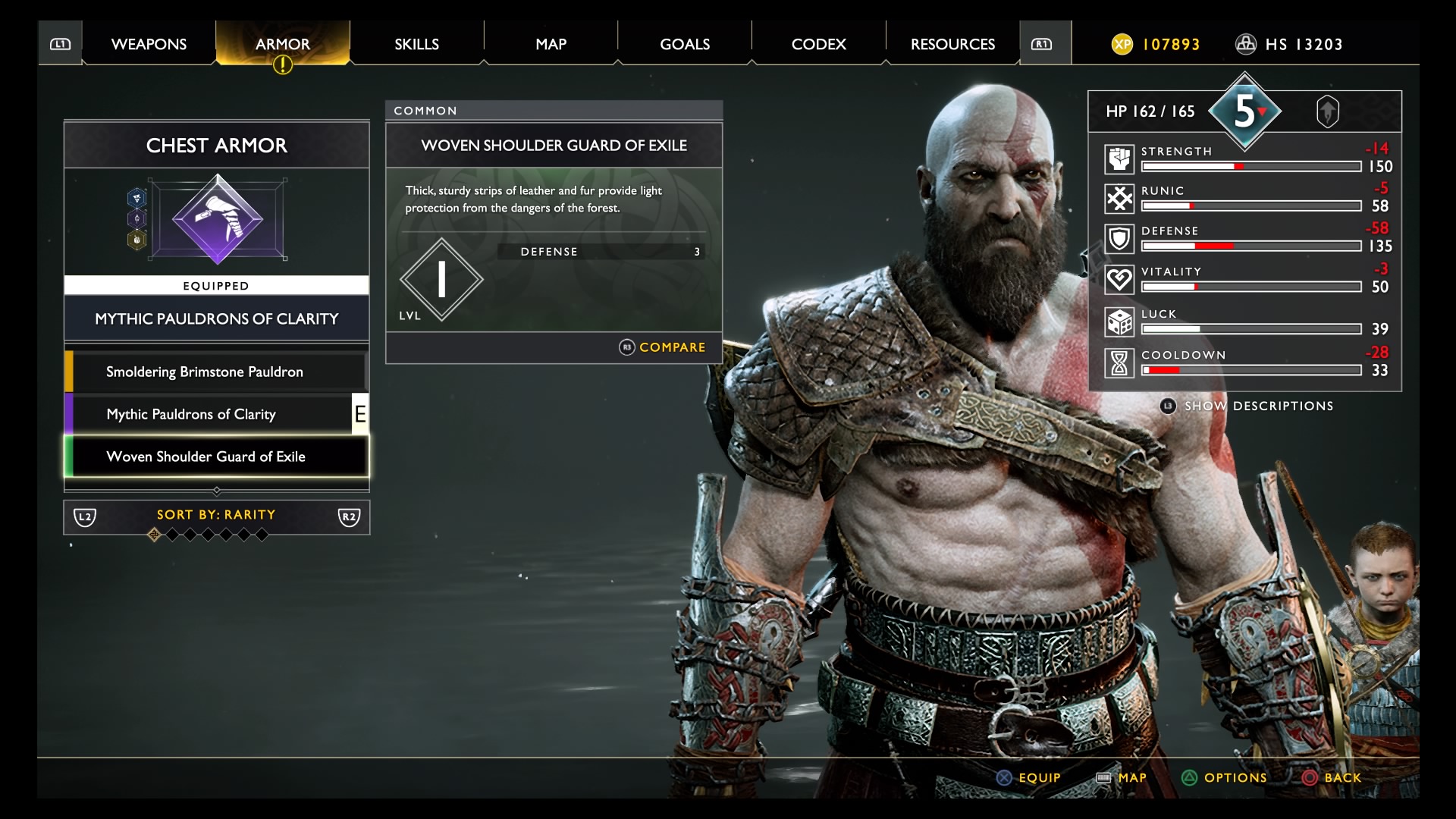
Your ‘Skills’ progression is a little bit different than your equipment progression. You collect materials and Hacksilver to upgrade weapons and gain XP to upgrade your combat moves. You will unlock new move sets fairly frequently that you’ll be able to use against the different varieties of enemies; all with their own particularities. Enemies can control various elements (like poison or fire), come in different sizes (from wolves to giants) and travel in different ways (such as flying and phasing). You will be wowed the first time that you roll under a huge horizontal swing from the sword of a Traveler, confront a troll with giant stone column in hand or crush an enemy’s head after placing them in a wrestling hold.
God of War’s Structure
You have a single main quest in the new open world of God of War: the Journey. This mission is divided into several different sub-quests, but beyond this, the world is populated with tons of different challenges and even completely optional areas for you to explore at your leisure. The game even subtlety reminds you through character dialogue that you have optional side quests to complete.
Favors and Labors are two of the biggest parts of optional content in the game. Favors are traditional side-quests with story content given to you by an NPC. You’ll have the opportunity to explore caves for lost artifacts, take on arena challenges and defeat optional bosses. Labors are smaller tasks like killing a number of specific enemies, using a specific combat skill or finding specific items in the world. In addition to Favors and Labors, there are also Treasures to find using maps you’ll collect through your travels and artifacts to locate.
Soundtrack
Even the game’s soundtrack from Bear McCreary blends perfectly with the action. The densely orchestrated, brass-heavy songs exemplified in the title track, are stern and fit Kratos perfectly. McCreary has orchestrated the soundtracks for The Cloverfield Paradox, The Walking Dead, Battlestar Galactica, and others.
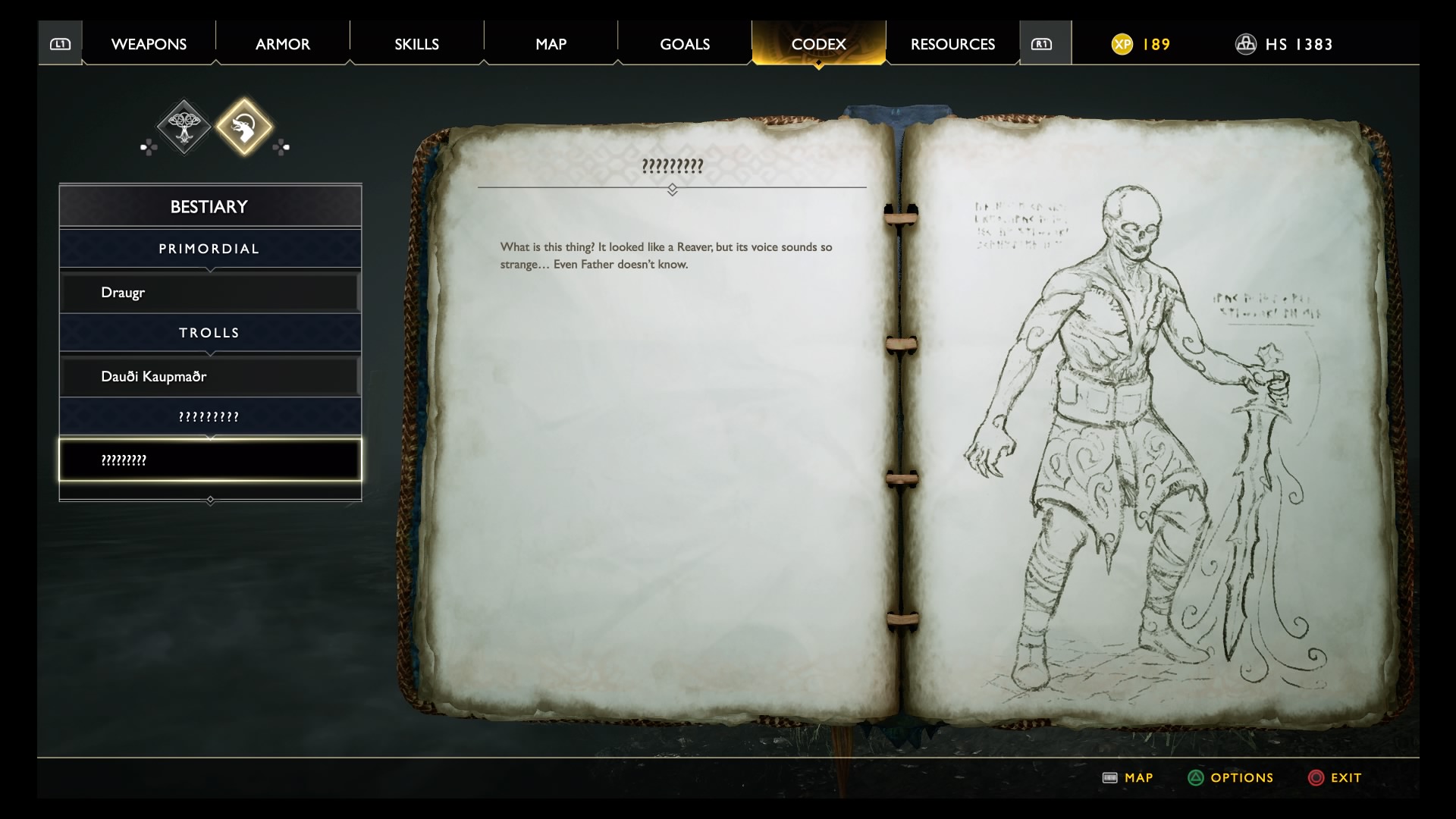
The Art of Subtlety in God of War
All of these elements: writing, directing, companion AI, combat, movement, progression, quests/side-quests and sound design all come together to create an incredibly dense package with care for even the subtle details. Did you notice all of the text in the game’s Bestiary is written from Atreus’ perspective? What about the care that the animators took in capturing specific movements for the death of flying enemies? Even smaller, when a secondary character tells you back-stories about some of the other characters while you’re rowing, he will stop telling them when you exit the boat and will pick up the story where you left off when you re-enter. The game even has a podcast to fill in details about the game’s lore (available on iTunes and Google Play).
These details separate great AAA games from the industry’s best.
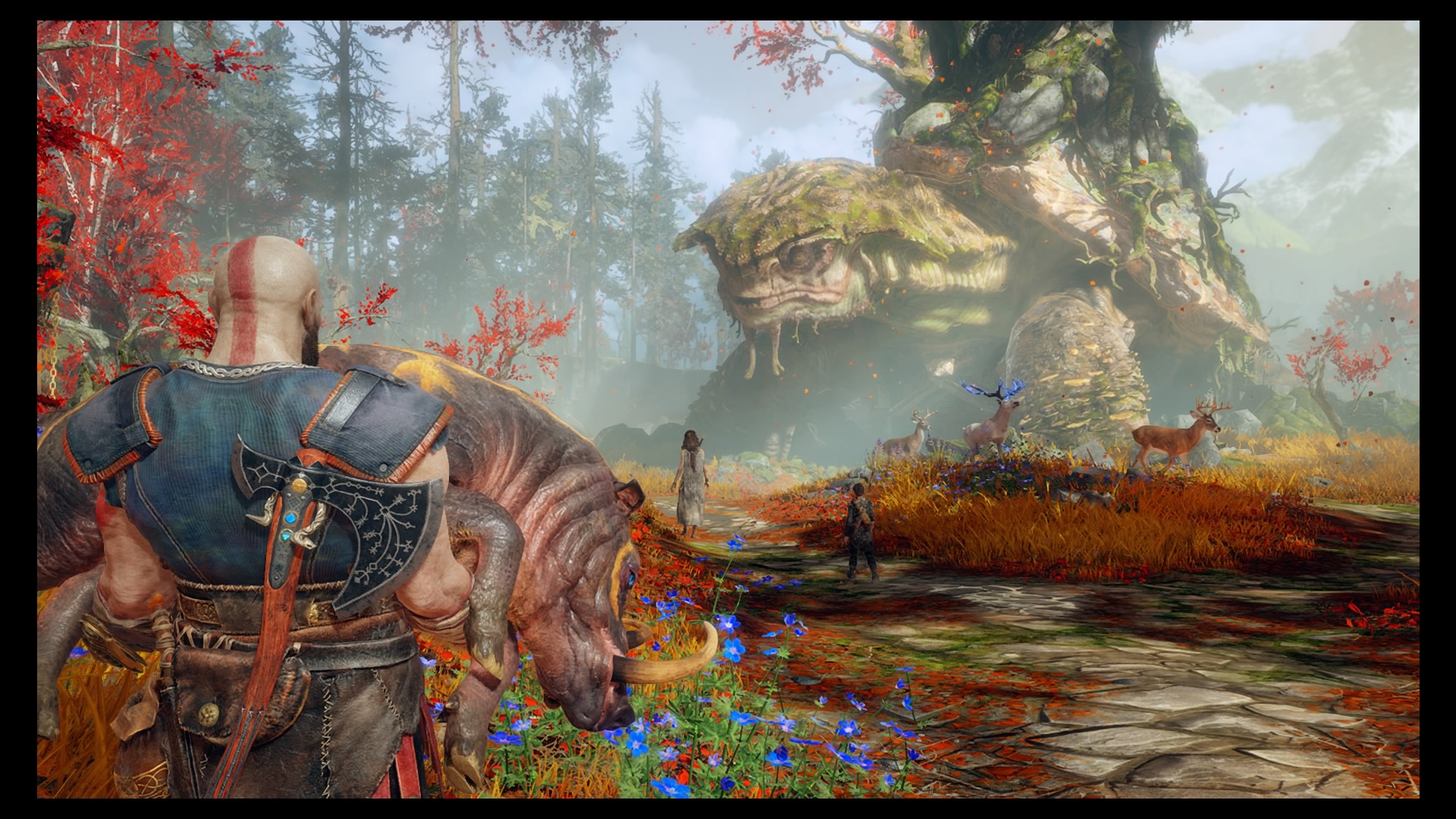
Wrap-Up
God of War realizes a sense of wonder and adds color to a series that only saw red in previous iterations. The experience is a perfectly tuned dream and the way that Kratos parents Atreus will leave you thinking about the father figures in your own life.
There’s an odd duality between the trajectory of this game and the main characters within it. Many have said that children usually turn out exactly like their parents. Despite his lineage, Kratos is an imperfect being and like many of us, he struggles with what qualities to pass on to his kin. I’m imagining Sony Santa Monica wrestled with the same problem. God of War could have been more like the original games. But it succeeds by taking only the best parts from the original games (scale and moments from Kratos’ past) and creates a new experience that eclipses the past games in a way that I never imagined possible.
You’ll have to play the game to see if Kratos succeeded with nurturing Atreus as well as Sony Santa Monica nurtured God of War.
Final Score: 10/10
God of War is a gameplay triumph, beacon of storytelling in this generation of games and most importantly, it’s incredibly satisfying to play.
A digital copy of this game was provided by the publisher for review purposes.
The screens and footage within this review were captured on a standard PlayStation 4 console.
This article was originally published on Scholarly Gamers; re-published with permission.

Jacob is a creator marketing professional, and a fan of video games. He hosts/produces the Left Behind Game Club and is a co-host of Crossplay Conversations. At conventions and bars, he also hosts Video Game Trivia.
